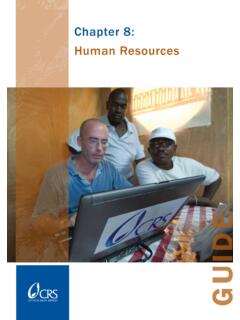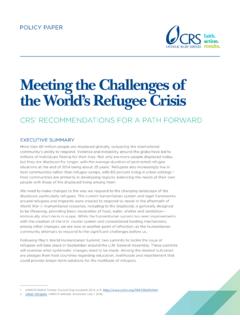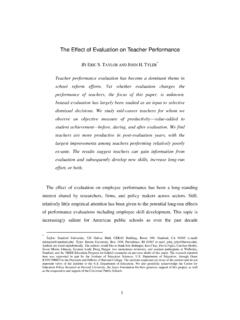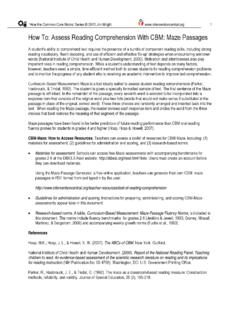Transcription of PRACTICAL GUIDE Focus Group Discussions
1 Focus Group DiscussionsPRACTICAL GUIDEA cknowledgmentsSpecial thanks to Dominique Morel, for numerous reviews, thoughtful guidance, encouragement and support, and to Michelle Ryan and Jennifer Blinkhorn, who wrote the sections on FGDs with of the GUIDE were informed by Snigdha Chakraborty s notes and training materials on gratitude to the EMECA MEAL4 Kids learning event participants (September 2017) for their field perspectives, and to the EMECA country program staff whose thoughtful input during trainings, technical visits and other interactions greatly improved the practicality of the Velida Dzino-SilajdzicReviewers and contributors Dominique Morel, Snigdha Chakraborty, Noha Eldakrory, Emily Nucciarone, Michele Ryan, Clara Hagens, Mohit Holmesheoran, Caroline Millet and Samuel Relief Services is the official international humanitarian agency of the United States Catholic community.
2 CRS relief and development work is accomplished through programs of emergency response, HIV, health, agriculture, education, microfinance and peacebuilding. CRS eases suffering and provides assistance to people in need in more than 100 countries, without regard to race, religion or nationality. 2018. Catholic Relief Services. You may adapt and build upon this work non-commercially for educational purposes as long as CRS is acknowledged. For further information: or write to:Catholic Relief Services 228 West Lexington Street Baltimore, MD 21201-3443 USA Focus Group Discussions Are and When to Use Them ..1 FGD Design: Where and How to Start ..3 Designing the FGD GUIDE .
3 9 Preparing For and Managing Fieldwork ..14 Conducting FGDs ..16 Analysis and Interpretation of FGD Data ..22 Final Words ..32 AcronymsCFS child friendly spacesCRS Catholic Relief Services FGD Focus Group discussion KII key informant interviewMEAL monitoring, evaluation , accountability and learningMOE Ministry of EducationNFI non-food itemNGO nongovernmental organizationRTA regional technical advisor1 PRACTICAL GUIDE : Focus Group DISCUSSIONSCONTENTSWhat Focus Group Discussions Are and When to Use Them1. Adapted from Guidance on Participatory Assessments (Dummett et al 2013)2. In mixed -method research, comparing and relating may result in conflicting findings between data collected through different methods.
4 Lack of agreement is a sign that additional qualitative data collection or additional analysis may be needed, potentially leading to new emergent understandings of complex social phenomena. (Wagner et al. 2012)WHAT IS A Focus Group DISCUSSION (FGD)?A Focus Group discussion is a qualitative data collection method that engages 6 to 12 people with shared characteristics pertinent to the specific discussion topic and is led by a trained facilitator. The shared characteristics may relate to a particular problem, livelihoods occupation, age, social Group , place of residence, experience of adopting or not adopting a specific behavior promoted by a project, The discussion is facilitated using a semi-structured interview GUIDE to foster active participation and in-depth discussion.
5 The semi-structured nature of the discussion intends to probe specific, predetermined topics while allowing flexibility, and stimulating participants to share and discuss among each other. An FGD aims to gain insights into people s motivations and social practices, as well as how they view or perceive their experiences, communities, and other aspects of life. Like all qualitative methods, FGDs use open-ended questions to collect qualitative data words and narrative explanations. An FGD is not a Group interview that results in a collection of individual participants responses. Rather, it encourages the participants to talk to one another, discuss and build upon or challenge each other s opinions.
6 An FGD does not generate data on a number or percentage of respondents with one or the other position; rather it generates data on the number of FGDs that reached or did not reach a consensus on the issue under investigation. WHEN DO WE USE FGDS IN THE PROJECT CYCLE?FGDs can be used at various stages of our work including during assessments, at baseline, and for monitoring and evaluation . They can be used in parallel with quantitative methods, before or after quantitative data collection, or used during assessments can help with understanding the perceived needs and priorities of an affected population and probe issues identified through secondary data review. Assessments typically use only qualitative methods so FGDs are often combined with observations or key informant interviews (KIIs), ranking exercises, etc.
7 FGDs held before quantitative data collection can help explore, design or refine the quantitative data collection tools. you may use FGDs to explore beneficiary perception of the main factors that influence resilience and use findings to develop a quantitative tool to measure it at baseline and done after quantitative data collection can help probe deeper into why or how certain things have or have not occurred. This can be used during monitoring to understand why certain quantitative indicators targets have not been achieved ( why households do not use a certain knowledge or skill taught at trainings), and generate evidence to inform immediate remedial action. In these cases, FGDs help explain quantitative evaluations FGDs can similarly help explore why certain changes have or have not happened.
8 They can be used simultaneously with quantitative methods and tools to compare or relate data collected through mixed methods. A Focus Group discussion is a qualitative data collection method that engages a Group with shared characteristics, and is led by a trained GUIDE : Focus Group DISCUSSIONSCONTENTSThe decision on when to conduct FGDs and in case of a mixed -methods approach their sequencing in relation to the other methods is influenced by the objective of the effort; the overarching assessment, monitoring or evaluation questions the FGDs seek to respond to (herein referred to as learning questions); and the human and financial resources available for the AND DISADVANTAGES FGDs are considered a low-cost method whose flexible format allows the facilitator to explore unanticipated issues.
9 Because of their flexible design and the exchanges among participants, the Discussions may lead to the discovery of attitudes and opinions that may not be revealed through methods targeting the individual, such as structured interviews, surveys or semi-structured key informant interviews. The FGD enables rapid collection of multiple perspectives on the topics under investigation, thus generating more information faster than in individual interviews. Interaction among FGD participants provides rich insights, and checks and balances, thus minimizing unique or outlying opinions. FGDs are an excellent method for obtaining information from, and hearing the concerns and ideas of, communities that cannot read or write.
10 But an FGD may not be the best method to explore sensitive topics that may bring a sense of shame or discomfort to the participants. Disadvantages include: Susceptibility to facilitator s bias, which may undermine the validity and reliability of findings. Limited confidentiality of information shared during the discussion. The risk of the discussion getting sidetracked by topics that may not be the primary Focus . The risk of the discussion being dominated by one or more individuals, thus silencing other participants or simply making them agree with the most dominant person. As with any qualitative method, the data generated through FGDs cannot be generalized to the entire population; FGDs indicate a range of views and opinions but not their distribution within the community.

















